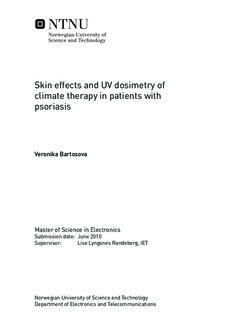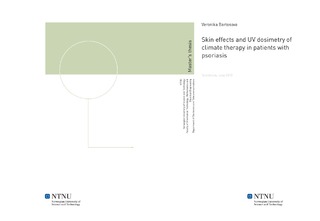| dc.contributor.advisor | Randeberg, Lise Lyngsnes | nb_NO |
| dc.contributor.author | Bartosova, Veronika | nb_NO |
| dc.date.accessioned | 2014-12-19T13:44:29Z | |
| dc.date.accessioned | 2015-12-22T11:42:28Z | |
| dc.date.available | 2014-12-19T13:44:29Z | |
| dc.date.available | 2015-12-22T11:42:28Z | |
| dc.date.created | 2010-09-04 | nb_NO |
| dc.date.issued | 2010 | nb_NO |
| dc.identifier | 348960 | nb_NO |
| dc.identifier.uri | http://hdl.handle.net/11250/2369502 | |
| dc.description.abstract | Sun exposure and climate therapy is an effective treatment for psoriasis. However, even though this treatment gives the patients relief from their discomforting symptoms, it has some potentially dangerous side effects such as an increased risk of skin cancer and premature skin aging. A prospective field study plans to follow the patients undergoing the climate therapy. During this study the UV dose to each patient will be monitored by personal dosimeters worn by the patients. Furthermore the patients' skin spectra acquired by the means of optical spectroscopy will be obtained daily. Both psoriatic skin a unaffected skin will be observed. These data will be used to assess the skin changes which take place during the psoriasis treatment. This project is focused on developing an automatic algorithm for handling bulk spectrometric measurements data and to propose ways of numerically evaluating the skin spectra. These numerical values will be later used to compare the daily patients' spectra and monitor progress of the treatment. An inverse model based on a lookup table and successive iteration was proposed in this project. The model matches the diffuse skin reflectance spectra modeled with a diffuse skin model with the measured patients skin spectra. The measured skin spectra are then defined by the diffuse skin model input parameters which were found by the inverse model. These parameters are oxygenation, blood volume and melanin absorption coefficient. Additionally four indexes were proposed to supplement the parameters found by the inverse model, namely the erythema index, melanin index, hemoglobin index and oxygenation index. Measurements of several skin spectra including psoriatic plaques spectra were carried out and used to test the inverse fitting model performance. The proposed model proved to match the measured spectra in an acceptable form employable for distinguishing between different measured spectra. The highest deviation is at the ends of the spectra due to the use of a constant value of scattering coefficient and additional parameters not directly relevant to sun exposure, hence not considered by the model. The proposed parameters together with the indexes proved to be a viable means of evaluating the healing in the psoriatic plaques as well as determining the changes caused by the sun in normal skin. | nb_NO |
| dc.language | eng | nb_NO |
| dc.publisher | Institutt for elektronikk og telekommunikasjon | nb_NO |
| dc.subject | ntnudaim | no_NO |
| dc.title | Skin effects and UV dosimetry of climate therapy in patients with psoriasis | nb_NO |
| dc.type | Master thesis | nb_NO |
| dc.source.pagenumber | 76 | nb_NO |
| dc.contributor.department | Norges teknisk-naturvitenskapelige universitet, Fakultet for informasjonsteknologi, matematikk og elektroteknikk, Institutt for elektronikk og telekommunikasjon | nb_NO |

